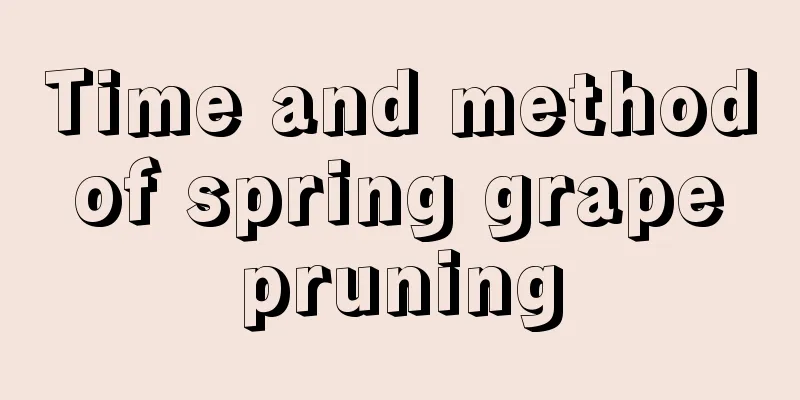Time and method of spring grape pruning

|
Grape is a perennial vine with very long branches. Spring pruning can control tree vigor, adjust the balance between growth and fruiting, promote the growth of new shoots, and lay the foundation for summer pruning. Below, the editor will introduce the time and method of spring pruning of grapes. Let’s take a look. 1. Spring grape pruning time The best time for spring pruning of grapes is usually between the end of winter and the beginning of spring, that is, February to early April. The exact timing varies by region, climate and grape variety. In southern regions, pruning may be done a little later due to relatively high temperatures. In northern regions, due to lower temperatures, pruning may need to be advanced to ensure that the vines can recover quickly and grow healthily after pruning. 2. Grape pruning method in spring 1. Remove the buds When the length of the new grape shoots reaches about 5 cm, the bud removal is carried out. Keep the strong buds and remove the weak buds, multiple buds and sprouting buds. Buds with inflorescences are retained, and buds without inflorescences are removed; if both buds have inflorescences, both are retained. 2. Thinning branches When the new shoots reach 15-20 cm in length, thinning should be carried out. Choose the branches to retain based on the size and distribution of the inflorescence. When cultivating on a single trellis, retain a new shoot every 10 cm; when cultivating on a double trellis, retain a new shoot every 15 cm. 3. Picking 3-5 days before flowering to the early flowering period, pinch off the fruiting branches, leaving 4-6 leaves above the inflorescence. Depending on the growth conditions and shelf space, pinch off the nutrient branches when they have 8-10 leaves. 4. Side shoot treatment Keep 1-2 lateral shoots on the top of the fruiting branches, leave 2-3 leaves on each lateral shoot and pinch them repeatedly, and remove all other lateral shoots. Depending on the space and growth conditions, some side shoots on the nutrient branches should be appropriately retained and pinched or shortened. 5. Thinning and pinching ear tips After fruit setting, thin out the clusters according to tree vigor and variety characteristics, removing excessive, too small, and too dense clusters. Generally, retain 1-2 clusters on each fruiting branch. Pinch the tips of the retained clusters and remove 1/4-1/5 of the top to make the clusters compact and the fruits uniform in size. The above is an introduction to the time and method of spring pruning of grapes. Spring pruning of grapes should be completed before the sap flow period to avoid sap flow caused by improper pruning. After pruning, the branches should be tied to the frame in time to keep them neat and ventilated. This is conducive to the healthy growth of the vines and the even ripening of the fruit.
|
<<: How and when to plant arrowhead mushrooms
>>: Passion fruit planting methods and management techniques
Recommend
Black corn planting time and method
Black corn planting time The entire process of bl...
What flowers are suitable for growing in Tongren? What are the city flowers and trees?
1. Climate characteristics of Tongren Tongren has...
How to Vernalize Hydrangea
Hydrangea is native to central and southwestern C...
What should I do if the green radish rots from the roots? Do I need to prune the roots?
1. The solution of soil culture Root rot of soil-...
How to care for torch flower during its flowering period
When does it bloom? Generally speaking, torch flo...
What is the market price of honeysuckle (what are the prospects and profits of honeysuckle planting this year)
In recent years, the cultivation of Chinese medic...
What to do if Amaryllis only grows leaves but does not bloom
1. Reasons 1. Lack of nutrients The plant needs a...
The efficacy and function of mango
effect The vitamin C content of mango is much hig...
How to grow blue apple succulents
How to grow blue apple succulent plants The blue ...
Common Phalaenopsis Pests and Their Control
Common Pests and Their Control Methods Scale inse...
Should I use a large or small pot for Begonia?
Should I use a large or small pot for Begonia? Th...
Does the fortune tree need to be exposed to the sun? How to expose it to the sun
1. Need to get some sun The money tree needs sunl...
How to grow gardenia in the north
1. Soil Gardenia likes an acidic environment, so ...
How to grow broad beans with high yield
Broad bean, also known as Luohan bean, Hu bean, o...
Can rice washing water be used to water Schefflera chinensis? The correct way to water rice washing water
Watering Schefflera chinensis with rice water You...









